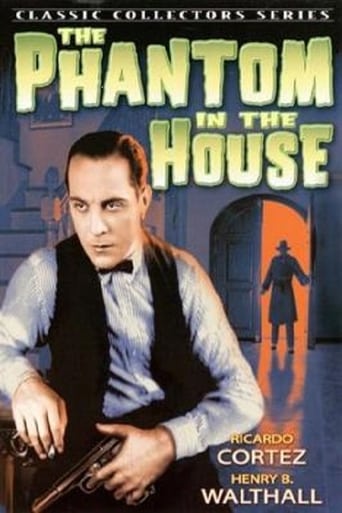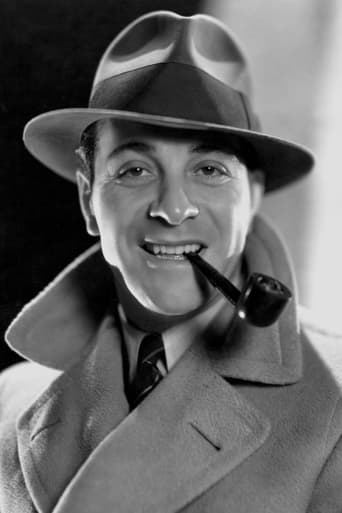The Phantom in the House (1929)
A man is blamed for a murder that was actually committed by his wife.
Watch Trailer
Cast
Reviews
Yawn. Poorly Filmed Snooze Fest.
Truly Dreadful Film
Sick Product of a Sick System
One of the worst ways to make a cult movie is to set out to make a cult movie.
The Phantom in the House (1929) ** (out of 4)Peggy (Grace Valentine) accidentally kills her lover just as her husband Boyd (Henry B. Walthall) walks in. Boyd agrees to say he did the crime and spends the next fifteen-years in prison. When he's released he meets back up with the wife but both agreed not to tell their now adult daughter Dorothy (Nancy Welford) that he's really daddy. Soon she wanting to marry Paul (Ricardo Cortez) but he's accused of a murder he didn't really commit. This leads Boyd with a decision to make.If you watch enough of these early sound pictures then you'll notice a few things. For starters, there's usually some sort of musical number for no reason. Second, there's usually a lot of boring dialogue that means absolutely nothing to the story. The third thing you'll notice is that there's usually enough plot for ten different movies. All of this can be understood because sound was something new and people wanted to hear it.With that said, those three things usually make these early talkies rather difficult to watch today and there's no question that this here is one of the silliest I've ever seen. The entire plot is just downright crazy and stupid. What makes matters even worse is that the love affair, the murder, the lie and the prison term is all handled in the first seven minutes of the movie. From here we get on to the new stuff with the daughter getting involved with a man her mother doesn't approve of. This here leads to another murder and we're off on a whole new storyline.The best thing about this picture is Walthall who really was a very good actor. He was perfectly capable of handling silent pictures and he made the transition to sound very well. He's very low-key here but he's certainly easy to follow and you can't help but enjoy the performance and the character Cortez gets the top-billing but the picture certainly belongs to Walthall as he's the actual lead. The supporting performances are mixed to say the least with Valentine coming off the worst with her overacting.THE PHANTOM IN THE HOUSE is a pretty routine drama and for the most part it's very boring. The over-the-top nature of the story and the fact that it was an early sound picture help keep it mildly interesting but for the most part it's a dud.
During the twenties Ricardo Cortez was talked of as a successor to Rudolph Valentino and was even billed over Greta Garbo in "The Torrent" but in 1929 he was just one of many stars running scared of the microphone. He didn't have to worry as he had a voice perfectly suited to talkies but that's where the small independent studios came in. While the majors scrambled around wondering if talkies were just a fad, studios like Continental and Tiffany just kept plodding along hiring sound stages and luring actors like Cortez who wanted to prove that talkies held no fear for them and their contracted studios could rest easy. His co-star Nancy Welford was a British actress who had just scored a hit in "Gold Diggers of Broadway" but it seemed if you made your mark in an early sound singie you were given short shrift if you wanted to go dramatic. Poor Nancy only made a couple of films including a "Broadway Brevitie" before disappearing into the shadows!!Even though Cortez and Welford were top billed the film really belonged to Henry B. Walthall in the type of role that was soon to be a staple for him in the talkies - he plays Boyd Milburn, a "genius" inventor who takes the blame when he arrives home and finds his wife standing over a man's body. Little does he realise that Peggy had offered herself to the man for her husband's advancement in the scientific world. Peggy's character is pretty questionable throughout the movie - the first scene shows her as saintly, willing to make the ultimate sacrifice for her husband's fame. She seems to forget about him when he is in prison, then when he is released he finds that she has transferred all his patents to her name and she is reaping the benefits and wealth while he is now impoverished.And what a house she lives in!! For a little studio (Continental) they must have lavished most of their budget on the very stylish Art Deco sets. From the beautiful Tiffany style lamps to the gorgeous tapestries to the very futuristic wall decorations.Only the nearness of his beautiful daughter, Dorothy (Welford), who of course thinks he is just an old family friend, keeps him sane. She has her own romantic woes, she loves and is beloved by Paul (Cortez) but her mother is desperately trying to foist a blithering stuffed shirt onto her. Even though Boyd steps in to fight for the young couple's happiness, Peggy is livid and threatens to ruin Paul - she has given him access to all of Boyd's patents. When the old judge who was instrumental in sending Boyd to prison is found murdered and Paul had been summoned to a meeting with him it seems logical that he will be arrested for murder. But Boyd has seen everything from his hiding place in the garden and, with Dorothy playing a big part, everything is able to end happily.Nancy Welford proves that as an actress she makes a great singer - all big eyes and funny little quips, she even warbles the theme song "Forgotten".
Not a bad effort for its era. People seeing the audience reaction in "Singin' In the Rain" are seeing an anachronism.That would be the reaction of a 1950 audience used to perfected talking pictures.But for audiences accustomed to silent movies,even imperfect sound was marvelous,making complicated plots like this far more practical than with silents. As others said, Henry Walthall and Ricardo Cortez give very professional performances. The film of course is "stagy", partly due to the limitations of sound equipment at the time but more due to the type of story it was.Even later efforts like"The Mask of Demetrius" were just about as stagy because of the nature of the plot. For one thing, this and other movies allow us to see basically what a stage melodrama of the period was like,something almost impossible to completely duplicate today,because todays actors simply didn't grow up in that old tradition. Still, the sets are very interesting, and it is somewhat filmic, allowing scenes and shots such as closeups that stage can't provide, so it is better than merely a filmed stage play. All in all a rather interesting movie.
THE PHANTOM IN THE HOUSE is a very, very old fashioned film--the sort of film that was common back in 1929 when studios first began making talking pictures. So, I cut it a lot of slack. However, when seen today, it really comes off very, very poorly.One of the first problems you'll probably notice is the sound track. The voices and lip movements are way out of sync on the DVD from Alpha Video and I assume all existing copies have that problem. One reason it was common in early sound films was that initially the sound was NOT included on the film strip but came on an accompanying record. Invariably, the record and film not be matched up perfectly--and this film is no exception. Additionally, like all such early films there is very little incidental music and sound effects--making for a strangely quiet film. By the early 1930s, this problem was eliminated, but the only way they knew to add music was to literally have a small orchestra stationed just off camera! h These were not the major problems in the film--just two you'll no doubt notice. However, a few more serious problems did impact how much I liked the film. The dialog was generally bad and the acting quite wooden, though there were some exceptions. Ricardo Cortez and Henry Walthall were professionals who already looked comfortable in front of the camera. This is especially true of Walthall who had been on stage quite a bit during his long career. The rest of the cast were not so skilled and it showed.Still, these were not the most serious problem in the film. The biggest single problem is the plot. It was hardly believable and the way some of the people acted was ridiculous. For example, when the film began, Walthall and his wife are in the room with a dead man--a man the wife had just killed. Walthall THOUGHT she'd been having an affair yet HE claimed it was him who killed the man! It was clearly self-defense--so why did he say he did it?! He spent 15 years in prison for something he did not commit AND he thought his wife was guilty! This made no sense. Additionally, while he was in prison protecting his wife, he was also sending patents for inventions to her and she became wealthy. When he was paroled, she wanted nothing to do with him!! Think about it--he saved her and provided for her so well that she now was quite rich YET she wanted him to just disappear! This, too, made no sense.Overall, the sound issues and dialog can be forgiven--after all, that the was the norm for 1929. But a clichéd and silly plot cannot--so I can't recommend you see this soapy film.





